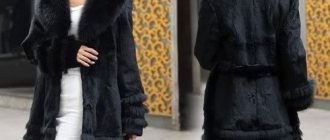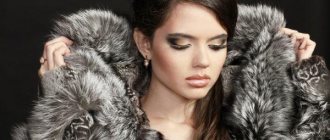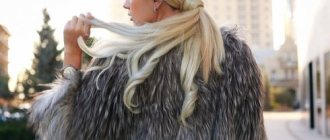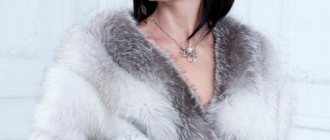Buying a fur coat in every woman’s head is associated with something unattainable, because such clothes are usually sold at an exorbitant price. However, you don’t have to spend hundreds of thousands of rubles to become the owner of a beautiful and fashionable fur coat. Just take a closer look at the fur coats from a rare animal – the kolinka. In this material, everyone can learn about the benefits of kolinsky fur and how much such a fur coat costs.
In the photo there is a fur coat from the column
Advantages of fur column
The kolonok is a small but valuable animal that is bred on a farm. It is considered quite rare, and items made from it are very prestigious to have in your wardrobe. This fur has a number of advantages, namely:
- at first glance it is almost impossible to distinguish it from mink fur;
- products made from it are very warm;
- has an affordable price;
- The fur quality is almost equal to that of expensive mink.
Every season, fashion dictates new rules to us, but this is least reflected in products such as fur coats. Coats from the kolinsky animal come in different shapes and types. Here are the styles that were included in the catalog of the most fashionable this season:
Appearance
The weasel animal weighs up to 800 grams, and its length, including the tail, ranges from 48 to 66 centimeters. It is distinguished by a small head, as well as noticeably shortened legs, between which membranes are poorly developed. The muzzle is pointed, the neck is very flexible, and the ears are pointed.
The beautiful and fluffy tail makes up approximately half the length of the entire animal - from 18 to 21 cm. The fur color is reddish-ocher. In winter, the fur becomes very thick and soft.
The muzzle has a brown tint, which is called a mask. The outline of the lips is clearly visible, as they are highlighted by a white stripe on the muzzle.
The Siberian weasel molts in March-May. Therefore, in the summer, he seems slimmer, since the fur is not so thick and fluffy.
Straight long fur coat
The description of long straight styles should start with the fact that they are classics, and classics never get old. Along with straight models, you can choose a fitted one to emphasize the slimness of your figure. If you have problems with weight, then a straight product is ideal.
Products that will reach the owner almost to the toes, sleeveless and with a hood are gradually coming into fashion. It is convenient to move in a product of this style, but, of course, in cold weather such a thing is practically useless. You can see examples of products in the photo. This fur coat can be worn with high heels and a skirt of any length. Such products look impressive and expensive.
Habitats
Siberian weeds are quite common in low-growing forests in Asia, and are also located in the southern zone of Siberia and the Far East.
In recent years, there has been an increase in the number and distribution of weasels in Yakutia along the Okhotsk coast.
Quite a lot of speakers appeared in the Cis-Ural region. The animals choose the valleys of small streams as their immediate homes, where they settle in windfalls, dead wood and mixed forests. They can also be found in rocky areas overgrown with bushes.
Colonies often climb mountains to heights of 1400 to 1700 meters. However, they can also be found on the outskirts of fields or small villages and cities.
Short fur coat
Short ones with wide ¾ sleeves are ideal for young people. A very fashionable style of the product will inevitably attract the attention of others, so you definitely won’t go unnoticed. As a rule, such products have a straight cut, but there are exceptions. You can wear this item with anything and anywhere. Recommended to be worn with long gloves.
Reproduction and lifespan
In February, speakers appear more and more often from under the snow. They are driven by the instinct of reproduction. At this time, males are fussily looking for girlfriends, neglecting the boundaries of their territory. Upon reaching a year, the animal is considered sexually mature; females are ready for mating from late March to mid-May.
If the coating was wasted or the brood died, then fertilization is possible a second time. You need to do it before August, when males end their sexual activity. In their shelters, females prepare a nest. A soft pillow is created from dry plant residues, bird feathers, and animal hair.
Pregnancy lasts 35–40 days. Usually 3–7 cubs appear, the maximum number is 12. One puppy was found in the nest of a Japanese itatsu. The brood is born deaf and blind, wearing a light downy coat. The first teeth erupt after 15 days, vision and hearing after a month.
After another two weeks, the fur coat acquires a more saturated reddish color, and a mask appears on the face. At the same time, the first crawls out of the nest occur. The mother alone participates in feeding and raising the offspring. When she goes hunting, she cleverly disguises the entrance to the shelter. If necessary, it bravely protects its cubs.
For the first two months, the brood feeds on milk, and later on small rodents and birds caught by the female. By autumn, the young animals become the size of an adult, leave the shelter, and begin an independent life. In nurseries or at home, speakers live 9–10 years. In the wild - 2–3 years. There are long-livers who die from natural causes at the age of six.
Source
Straight short fur coat
Short, straight-cut products are the most versatile type of product. Even if it occurs to you to wear them with sports shoes, this will not be considered bad manners. Many products of this style have a hood. And since the fur of this animal is very warm, the fur coat can be worn without a hat.
What the reviews say
You can find many reviews with a detailed description of this or that item from this animal, which greatly simplifies the choice. Reviews about a fur coat from a column confirm its excellent ability to retain heat and ideal appearance.
Reviews about such products vary, as do descriptions of people’s personal experiences. There are a huge number of catalogs of fur coats from a column with photos, from which you can easily and without unnecessary nerves choose what is right for you, simply by looking at the image and reading the description. Products made from these small animals leave almost no one indifferent. Who doesn't want to buy something that won't cost much but will look like a million dollars? That is why various designers are adding more and more new products made from this fur to their catalogs.
If we take into account the comments that consumers leave, such products must be worn very carefully, otherwise they will last you no more than one or two seasons. If you lead a fairly dynamic lifestyle, then you should be very careful about the type of purchase you make.
Description and features
The wild predatory weasel of the weasel family is small in size (the length of the body from the muzzle to the tip of the tail is a little more than half a meter) and weighs no more than 800 g. On its cute elongated muzzle one can see round, wary eyes, whiskers sticking out to the sides and a black nose. The kolonok in the photo is a cute animal of a dense build with short rounded ears.
The red color of the Siberian weasel, more intense on the tail, becomes lighter in winter. On short paws you can see small membranes. A dark mask stands out on the muzzle, and there is a white border around the lips and on the chin.
By the beginning of November, after the autumn molt, the animal’s coat is especially thick, and the tail, which occupies one third of the entire length, is fluffy. The change from winter to summer fur begins in March and continues until August. The tail is the last to shed.
The animal in the bright summer dress for long. Already in September, the time of autumn molting begins, which is more fleeting. The fur falls out in clumps, forming bald spots on the sides and back. The sounds made by mustelids are whistling, chirping, hissing.
In addition to the common Siberian, zoologists distinguish other types of columnar . Japanese, the second name for itatsi, was brought to the island. Sakhalin from the island Hokkaido. Its representatives have a thin body and a narrow head. In winter, the tail is thicker than the minks.
The color, like that of the Siberian, is red, but with richer shades - peach, reddish-brown, orange. If the Siberian weasel has a belly that is several tones lighter than the back, then the Japanese weasel has a dark belly. The main difference is sexual dimorphism. Females weigh half as much. With an average body length of a male of 38 cm, the length of a female does not exceed 30 cm.
Itatsi live on the southern part of the island in the upper reaches of non-freezing springs and river valleys. Advancement to the northern areas was hampered by harsh climatic conditions. The population has sharply decreased due to hunting, introduced sable and mink. Now the number of animals does not exceed three hundred individuals.
Scientists still cannot agree on the classification of Japanese kolonka. Some consider itatsi a separate species, others an island form.
The Far Eastern weasel , which lives on the mainland, differs from the Siberian subspecies in its place of settlement. The dividing border of their settlements runs along the Zeya. As for morphological characteristics, the Far Eastern species is larger and brighter in color.
Lifestyle and habits
Kolonok leads a sedentary lifestyle. Most often, the Siberian weasel settles in the burrows of chipmunks, voles, tree hollows, under fallen trees, and in dead wood. In addition to the main dwelling, the colonel necessarily has several temporary ones scattered throughout his hunting area, which he uses as needed.
During severe winter cold, the Siberian weasel may not leave its home for several days, falling into a kind of short-term hibernation for several days.
The animals do not mark or defend their territory in any way. Siberians may leave their hunting area due to lack of food, or during the mating season.
The Siberian weasel is mainly nocturnal. The Siberian moth becomes most active during twilight and after sunset. In winter, the animal can be active during the day. In search of food, the animal can travel up to 10 km per night. At night, you can see the glowing reddish eyes of the weaselfish hunting for rodents. On the ground, the animal moves in rapid jumps.
The kolonok is a very dexterous and agile animal, brave, curious, able to climb into crevices and hollows, climb trees and rock tops.
The Siberian weasel can swim well and is able to swim a considerable distance from the shore; water rats, muskrats and river fish often become its prey.
In winter, while hunting for capercaillie and hazel grouse hiding under the snow at night, a weasel weasel that smells birds is able to make its way under the snow to a distance of up to 50 meters and with a swift rush get a bird for itself.
An interesting feature of the columnar is that no matter where he gets his food, he eats it only in his home.
The speaker's voice is similar to that of a ferret: the speaker can chirp and chirp, and when irritated it makes a hissing whistle.










